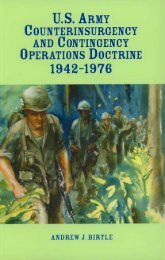C. Wiebes - Intelligence en de oorlog in Bosnië 1992-1995. De rol van de inlichtingen- en veiligheidsdiensten - Engels
C. Wiebes - Intelligence en de oorlog in Bosnië 1992-1995. De rol van de inlichtingen- en veiligheidsdiensten - Engels
C. Wiebes - Intelligence en de oorlog in Bosnië 1992-1995. De rol van de inlichtingen- en veiligheidsdiensten - Engels
- No tags were found...
Create successful ePaper yourself
Turn your PDF publications into a flip-book with our unique Google optimized e-Paper software.
347lea<strong>de</strong>rship of the Republika Srpska for political reasons, accord<strong>in</strong>g to an analyst. If the VRS shouldnonetheless take action, th<strong>en</strong> this would probably be conf<strong>in</strong>ed to OPs; occupation of large sections ofthe <strong>en</strong>clave was thought unlikely for the time be<strong>in</strong>g. 1952 At the <strong>en</strong>d of June the MIS/army did notexpect any major changes <strong>in</strong> the positions of the warr<strong>in</strong>g factions. 1953A brief<strong>in</strong>g by the MIS/Army on 5 July <strong>de</strong>alt with the chances of an attack. Which ad<strong>van</strong>tagesand disad<strong>van</strong>tages could this have for the VRS? One reason to attack was that the VRS nee<strong>de</strong>d asuccess that could not be achieved elsewhere. Furthermore, this could be conducted with relatively littleeffort and without many casualties on its own si<strong>de</strong>. Moreover, the VRS would th<strong>en</strong> have a free hand <strong>in</strong>Eastern Bosnia and could significantly short<strong>en</strong> the l<strong>in</strong>e of confrontation. A disad<strong>van</strong>tage was that theBosnian Serbs would be se<strong>en</strong> as the guilty party and the Americans would urge reprisals. There were avariety of reasons not to attack. The ABiH <strong>in</strong> Goraz<strong>de</strong> was strong and well-organized. Zepa, <strong>in</strong> contrastto Goraz<strong>de</strong>, did not provi<strong>de</strong> any improvem<strong>en</strong>t to road and river communications. The analysts believedthat Srebr<strong>en</strong>ica could <strong>in</strong><strong>de</strong>ed be tak<strong>en</strong> <strong>in</strong> a relatively short time, but that the VRS would have to makeconsi<strong>de</strong>rable sacrifices to do it. It was easier to work for collapse from with<strong>in</strong>. Moreover, the <strong>en</strong>clavecould be tak<strong>en</strong> piece by piece.It was already possible to use the southern road follow<strong>in</strong>g the tak<strong>in</strong>g of OP-E. From April 1993onwards the road lay on VRS territory with the exception of a small section at OP-E. The bauxite m<strong>in</strong>ewas also <strong>in</strong> VRS hands, but lay with<strong>in</strong> reach of the ABiH. Tak<strong>in</strong>g the <strong>en</strong>tire <strong>en</strong>clave could be attractive<strong>in</strong> that it would provi<strong>de</strong> a good north-south route. If the VRS <strong>de</strong>ci<strong>de</strong>d to take apart the <strong>en</strong>clave piece bypiece, th<strong>en</strong> consi<strong>de</strong>rable difficulties could be expected with the ABiH. The Muslims could isolate OPs,use UN troops as a shield or kill a number of UN soldiers and th<strong>en</strong> give the VRS the blame. The ABiHcould attack Dutchbat to ga<strong>in</strong> heavier weapons, or isolate the battalion by surround<strong>in</strong>g it with civilians.This could be organized <strong>in</strong> a few hours and would r<strong>en</strong><strong>de</strong>r Dutchbat immobile. 1954 The MIS/Armybrief<strong>in</strong>g thus did not give <strong>in</strong>dications of an attack, ev<strong>en</strong> though a certa<strong>in</strong> predictive value could not bed<strong>en</strong>ied.The MIS/Army therefore did not have prior knowledge. The <strong>in</strong>tellig<strong>en</strong>ce section of the ArmyCrisis Staff had its suspicions, but it never expressed these out loud. In the daily brief<strong>in</strong>gs it constantlystuck to the MIS/Army analysis. All parties <strong>in</strong>volved thought that the attack was aimed at the southernroad and the adjac<strong>en</strong>t bauxite m<strong>in</strong>es. In the worst case Dutchbat would be forced back <strong>in</strong>to a small(VRS ‘recognized’ Safe Area) around Potocari. This reduction <strong>in</strong> size would have roughly correspon<strong>de</strong>dto the Bosnian Serb <strong>in</strong>terpretation of the <strong>en</strong>clave bor<strong>de</strong>rs, i.e. the actual <strong>de</strong>militarized area of April19551993. Accord<strong>in</strong>g to one MIS official the MIS/Army had started to receive reports of movem<strong>en</strong>tsaround the <strong>en</strong>clave as early as the <strong>en</strong>d of June. Communications l<strong>in</strong>ks were be<strong>in</strong>g laid by the VRS alongthe l<strong>in</strong>e of confrontation, which <strong>in</strong>dicated the <strong>de</strong>sire to communicate securely. Buses had be<strong>en</strong>observed too. What did this mean? Tanks had also be<strong>en</strong> reported and heard by OPs, but it wasconsist<strong>en</strong>tly assumed that the VRS was <strong>in</strong>terested only <strong>in</strong> the southern road. 1956The Head of <strong>Intellig<strong>en</strong>ce</strong> Production and also act<strong>in</strong>g Head of <strong>Intellig<strong>en</strong>ce</strong> of the MIS/Army<strong>de</strong>clared, however, that there were ‘absolutely no’ tactical <strong>in</strong>dicators that revealed a pattern.Observations from the <strong>en</strong>clave were particularly summary, and the only possible source of <strong>in</strong>formationcould have be<strong>en</strong> American UAVs (unmanned aerial vehicles). But the Americans never passed this<strong>in</strong>tellig<strong>en</strong>ce to the Netherlands. However, the Dutch official forgot to m<strong>en</strong>tion that the Dutch F-16swere also very suitable TACRECCE assets which could have be<strong>en</strong> used outsi<strong>de</strong> UNPROFOR. In thisrespect a s<strong>en</strong>ior US <strong>in</strong>tellig<strong>en</strong>ce official compla<strong>in</strong>ed to the author that it was all too easy to lam<strong>en</strong>t about1952 MoD, MIS/Army. INTSUM 109/95, 09/06/95.1953 MoD, MIS/Army. INTSUM 120/95, 26/06/95.1954 MoD, MIS/Army. Notes on brief<strong>in</strong>g dates 5 July<strong>1995.</strong> No author <strong>in</strong>dicated.1955 MoD, SMG. Report of conversation with Colonel <strong>De</strong>dd<strong>en</strong>, 10/08/95.1956 Confid<strong>en</strong>tial <strong>in</strong>terview (38).





